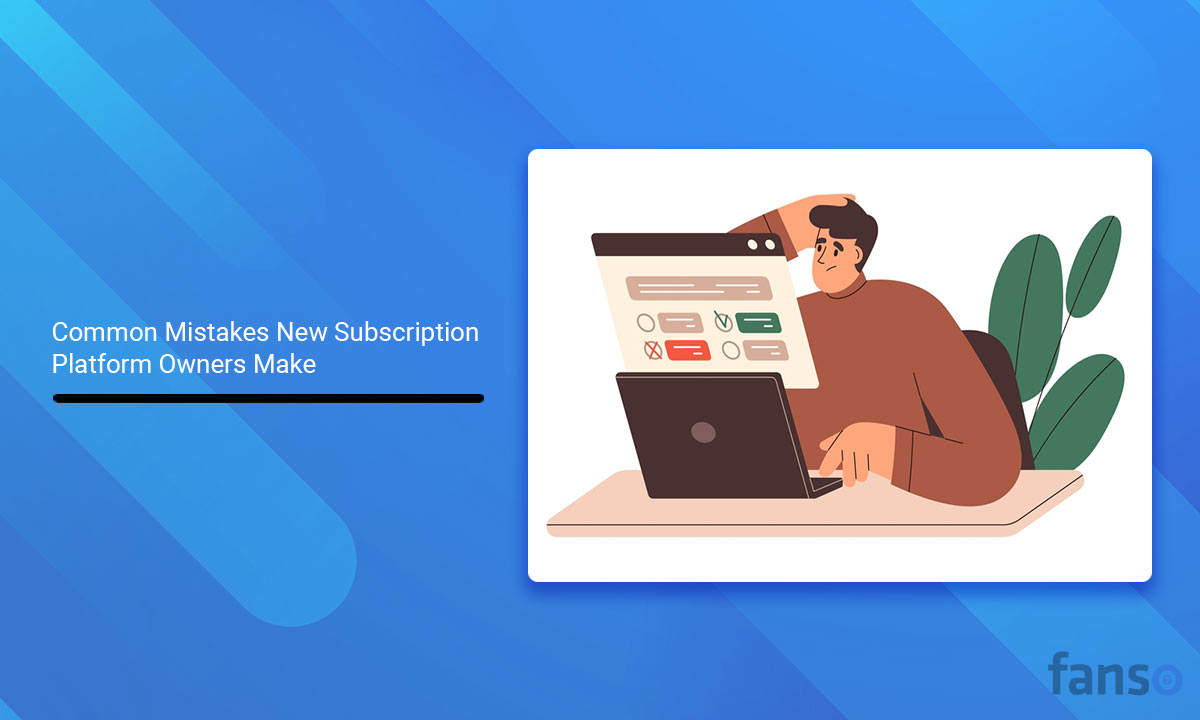The subscription business dates back to publishers and magazines. Recently, it has become popular as a hot pick for selling digital products. From Substack solopreneurs to Peleton memberships, find innovative ways to entice prospects into the subscription web.
With a slew of subscription platforms, finding success remains a substantial feat! If you are planning to start your subscription business, you’re in luck. We have put together nuggets of wisdom – on common mistakes made by subscription businesses.
So, avoid these important business lessons while running your subscription site!
Top 10 Mistakes Made By Subscription Business Owners
Whether you’re launching a subscription box or an online community, you need to perfect your subscription platform launch!
Here are some pitfalls you should avoid while building your subscription business.
Mistake #1: Not Doing Enough Research For Your Subscription Idea
The first step to setting up a solid subscription business is doing your groundwork. Analyze if there is a need for your product or service in the market.
Does it solve a significant gap in the industry?
If there is no significant market for your product, you cannot scale your business. This is fatal for your subscription business. Do thorough research of your target audience, industry problem, business model, etc.
Solution:
Validate if your subscription business is offering an effective solution.
Here’s how you can do that:
- Perform competitor analysis — understand their offerings, features, branding
- Create detailed buyer personas of your ideal customer
- Conduct surveys to get feedback from your audience
- Ensure your product has a unique value proposition
- Find related keywords or trends with significant search volume
Mistake # 2: Not Providing Good Customer Service
Customer acquisition costs are typically five times higher than retaining existing customers. However, once the business takes off, most businesses focus on attracting new customers. Some don’t consider the grievances of existing customers.
Dissatisfied customers leads to increased churn. Strong customer relationships are built on exceptional customer experiences. Hence, subscription businesses must offer 24×7 customer support from the launch day.
Solution:
Follow these strategies to offer excellent customer support:
- Know your customers well — needs, pain points, expectations
- Make it easy to access, and cancel your subscription service
- Integrate flexible options like – FAQs, chatbots, tutorials, feedback forms
- Deliver proactive and responsive support, eliminating the problem from the root
Mistake # 3: Charging Too Low or Not Enough for Your Product or Services
Price is not your unique business value proposition. A low subscription price can’t count as a competitive advantage.
If your price is too low, some customers might even doubt the quality of your subscription services. Price your subscription services based on its value.
Pro Tip: A great way to determine the price tag is to quantify your subscriptions. For example, if your subscription saves a certain hours of work e.g., 10 hours / month at $40/hr = $400/ month.
Solution:
Select an optimal price point based on your product value, subscription length, competition, target audience, etc.
You can’t just “go with your gut”.
Ask these questions to price your subscriptions right:
- Which pricing model should you choose (e.g., flat rate, tiered, usage-based, per-user)?
- How do you calculate your subscription pricing?
- How have competitors priced their products?
- What’s the price point preferred by your target audience?
Mistake # 4: Failing to Come Up with Fresh Content Ideas Every Month
Recurring revenue is an upside of subscription businesses. But it has its own challenges! You need to provide unique value to your subscribers every month.
Whether it’s a freshly brewed content update, a live event, or a rare industry resource, your customers are looking forward to it.
Deliver this promise – or brace the cancelations!
Solution:
- Include expert tips, step-by-step guides, tutorials tailored to your audience’s needs
- Create seasonal or theme-based content deliveries
- Host members-only live events, webinars, and referral programs
- Consider their needs or preferences with a set of onboarding questions This helps to offer a personalized experience
- Create a content calendar with – topics, post frequency, content type, performance
- Include customer feedback loops so your content resonates with the audience.
Mistake # 5: Prioritizing Content Quantity Over Quality
Has it been a while that you started your subscription site?
Then, you might be running out of content ideas.
Your customers don’t need a ton of ideas, they need ones that offer value.
This also answers the popular question – how many posts should I publish every month? Imagine posting 4-5 random posts on your subscription site or 2-3 value-packed posts.
Which one do you think would better resonate with the audience?
The key is to understand your audience and plan your content well.
Solution:
Content is the currency of your subscription site. Focus on the kind of content that works for your website.
Not sure where to start? Here’s how to create a calendar:
- Pick your content goals as per your target audience’s needs
- Experiment with different content types — courses, downloadable files, podcasts, newsletters, and community groups
- Organize them into content categories depending on your niche. For fitness and wellness, food, exercise, and mental health are categories
- Decide how to revamp it into practical content — checklist, tutorial, how-to guide, etc
- Start writing or producing your content
Mistake # 6: Not Taking Time To Know Your Audience
Customers are the heroes of your business narrative! Your subscription site experience should be compelling and rewarding for your customers.
Subscription businesses often fail because they don’t make much effort to know their audience. In an age when subscription businesses are booming, personalization is the way forward!
Solution:
To offer a unique business proposition, define your ideal member audience by:
- Crafting detailed personas – goals, needs, passions, professions, income, location
- Analyze content that engages the audience most
- Research similar communities on social media groups and forums
- Keep an eye on trends with Google Trends, BuzzSumo, Google Analytics and Semrush.
Mistake # 7: Not Creating Enough Product Versions
Consider a fitness website with a single subscription plan for all. Alternatively, there’s another website with three subscription tiers — for beginners, intermediate enthusiasts and fitness pros.
Which one do you prefer? Definitely, the second one.
Users can choose a plan based on their fitness level and pay accordingly.
Regardless of your niche, always aim to target different audience segments. This offers affordability and better choice to your customers. And customers love this freedom!
Solution:
Creating tiered subscriptions is an effective way to upsell, offer a personalized subscription experience, and maximize your revenue.
Consider these points to create subscription tiers:
- Create different subscription tiers targeting unique segments of the audience(e.g., good, better, best)
- Charge differently for separate subscription tiers based on their inherent value
- Include a free tier to test your subscription product or service
- Choose a payment gateway with recurring billing and a tiered approach
- Offer around 3-5 subscription tiers to avoid “decision fatigue”
Mistake # 8: Reduced Efforts on Marketing
Subscription businesses often get too absorbed with offering ongoing content value. Some businesses won’t invest much in marketing efforts.
But, branding and establishing your online presence is an essential step of building trust. Neglecting word-of-mouth marketing can influence the momentum of your business.
It’s essential to dedicate some time, budget, and resources to hands-on marketing.
Solution:
Here’s what a resounding marketing strategy looks like:
- Create free trials or freemium models for your subscription site
- Share enough social proof on social media – testimonials and case studies
- Create attractive referral programs to incentivize new members
- Host live webinars, podcasts, and blogs on current market trends and opportunities
- Use newsletters to promote enticing offers, onboard new users, launch new products
Mistake # 9: Re-inventing the Wheel
In the pursuit of quality-content, subscription businesses often try to be an idea generator. But it’s okay to reinvent the wheel sometimes!
For example, if a live fitness tutorial worked well, why not repurpose it into a handy how-to guide or a pre-recorded course?
Maybe you could appeal to a different set of audience altogether. The result? More time for promotions and audience engagement.
Solution:
Struggling with the creator’s block? Repurpose your content to keep those content blues at bay.
You can repurpose your best content pieces with:
- Evergreen content or content with more than one format possibilities
- Create e-books from in-depth content like guides, tutorials, listicles, statistics, etc.
- Develop video tutorials from how-to-posts, case studies, interviews, etc.
- Publish infographics from step-by-step guides, comparison posts, and industry insights
- Send newsletter series from case studies, blog posts, or experiences
Mistake # 10: Providing the Freemium Model Without Solid User Conversion Strategy
Today, customers are more curious than ever and eager to know what value their subscription offers. That’s why the freemium business model has worked its charm over the decade!
Customers can know their subscription value before fully committing to them!
But while businesses adopt the freemium model, there’s a catch: a solid conversion strategy to convert prospects into dedicated customers!
The freemium model is resource-intensive. If it doesn’t work, it can drain your business financially and technically.
Solution:
Freemium models are best suited for products with basic features or flat learning curves.
These tips can increase your freemium conversion rate:
- Offer limited features in the freemium version
- Define usage limits for free features, such as minutes, data, etc.
- Provide visual nudges with in-app messages prompting upgrades
- Build the FOMO feeling by listing what’s beneficial to them
Wrapping Up
Your membership site might not be an overnight success! It’s a series of successful lessons and failed trials.
But, your triumph is to pick up from your failures and learn from those who have already traversed the path before.
Knowing the typical errors committed by subscription owners helps you to avoid them. We have compiled a list of common challenges or errors that subscription business owners typically encounter.
Is there any challenge you came across in your subscription business? Let us know in the comments.
FAQs for Common Mistakes New Subscription Platform Owners Make
1. What are the biggest mistakes subscription-based businesses make?
Here are the top mistakes by subscription businesses:
- Not having a unique business proposition
- Inadequate research on your subscription business idea
- Charging a low subscription price for your product or service
- Not fully understanding your target audience
- Limited product versions
- Cutting down on your marketing efforts
- Prioritizing your content quantity over quality
- Not re-using your existing content
- Implementing the freemium model without a streamlined user conversion strategy
- Neglecting customer service in initially
2. How much content should I offer at my launch?
There is no one-size-fits all approach for publishing content on your subscription site. Everything depends on your target audience, topic, and platform goals. Consider your subscriptions as solutions, rather than mere content updates. Identify the major problems, and ensure you publish enough to solve them.
3. Why are my subscribers not engaging enough?
Low engagement could be due to:
- Poor content quality
- Irrelevant or cliche content
- Lack of audience feedback
- Poor user experience
4. Should I offer a free trial or a freemium version on my subscription platform?
Offering free or freemium versions is your choice. It depends on the target audience, business model and pricing strategy. You can attract free users from both the models. A free trial is great if your product has advanced features. A freemium model is great if you can deliver value in the free tier and your product has viral appeal.


